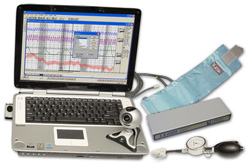What is Polygraph?
Polygraph means “many writings.” Many also refer to it as a “lie detector or truth verifier.” The polygraph is an instrument that will record physiological changes occurring within the examinee’s body as the examiner asks a series of test questions. The polygraph instrument is basically a combination of medical devices that are used to monitor changes occurring within the examinee’s body. As an examinee is questioned about a certain event or incident, the examiner records and monitors the relative changes in a person’s blood pressure, heart rate, respiratory rate, and electro-dermal activities.
Today, many polygraph tests are administered using digital computerized equipment. Western Polygraph uses a Lafayette Computerized Polygraph Instrument.

Polygraph examinations are most often associated with law enforcement investigations, but there are also a number of other uses for the polygraph. Many government entities and law enforcement agencies require a pre-employment polygraph screening in conjunction with the background investigation prior to employment. Additionally, attorneys use polygraph to verify the truthfulness of their clients. Private citizens are using polygraph related to fidelity issues.
The polygraph components:
Respiratory: Two rubber expanding tubes filled with air, called pneumographs, are placed around an individual’s chest and abdomen. When the chest or abdominal muscles expand, the air inside the tubes is displaced. The computerized polygraph employs transducers to convert the energy of the displaced air into electronic signals.
Blood pressure/heart rate: A blood pressure cuff is placed around the person’s upper arm. Tubing runs from the cuff to the polygraph. Again, these signals are converted into electrical signals by transducers.
Galvanic skin resistance: This is also called electro-dermal activity and is basically a measure of sweat on your fingertips or palm of a hand. The fingertips are one of the most porous areas on the body and therefore are a good place to look for sweat. Fingerplates, called galvanometers, are attached to two of the examinee’s fingers. These plates measure the skin’s ability to conduct electricity. When the skin is hydrated (as with sweat), it conducts electricity much more easily that when it is dry.
How Does a Polygraph Examination Work?
The polygraph examination is divided into three segments: The pretest phase, the data collection phase, and the data analysis phase.
In the pretest phase the examiner will complete the required paperwork and familiarize the individual with the testing procedure and the instrumentation. The examiner will review the entire process, to include the attachments, the process, the matter at hand and most importantly, the examiner will review every question with the individual. An individual walks into a polygraph that in itself is a brand new experience. The last thing anyone wants during an examination is to be surprised.
In the data collection phase the examiner administers the test and collects a number of polygraph charts depicting physiological changes occurring with the examinee’s body as the examiner reads each test question and the individual answers “yes” or “no.” That’s correct. These are simple yes and no answers.
In the data analysis phase, the examiner will carefully review and score each chart in order to render an opinion as to the truthfulness of an individual’s answers. The opinion rendered will be one of the following: No Deception Indicated meaning the individual answered the relevant questions truthfully, Deception Indicated meaning the individual did not tell the truth to the relevant test questions, or sometimes the opinion is Inconclusive/no opinion when the examiner is unable to determine truth or deception from the polygraph charts due to abnormal or inconsistent physiological reactions.
If Deception is indicated, the individual is given the opportunity to explain his deceptive physiological responses as displayed on his polygraph charts.
Who is Using Polygraph Testing?
Law Enforcement Agencies: Federal, State and Local
Legal Community – Probation, defense attorneys, District attorneys
Private Sector – Companies and Corporations under the restrictions and limitations of the Employee Polygraph Protection Act of 1988 (EPPA), private citizens in matters not involving the legal or criminal justice system, and attorneys in civil litigation.
Private Clients
The Employee Polygraph Protection Act of 1988 (EPPA) prohibits most private employers from using polygraph testing to screen applicants for employment. It does not affect public employers such as police agencies or other governmental institutions.
A great majority of our largest police agencies do have a polygraph screening program in effect. They primarily use the polygraph to screen applicants. The three leading benefits of polygraph screening were that job applications were more honestly completed; higher quality employees were hired; and there were fewer undesirable employees.
How Do I Find a Polygraph Examiner?
The results of your polygraph test may change your life. Make sure you have the test performed by the best polygraph examiner you can find.
When choosing a polygraph examiner the price of the test is the last thing you should ask about; affordability does not always equal quality. Remember the saying, “You get what you pay for.” Don’t put yourself in the hands of anyone but a highly trained and qualified professional. When selecting a polygraph examiner to conduct your polygraph test, inquire into the following areas involving experience, training, and qualifications:
The polygraph examiner should have completed a nationally recognized and accredited polygraph school which normally takes between 8 to 10 weeks to complete.
After completing the polygraph school, the new polygraph examiner conducts polygraph examinations during an “internship” period. During this period the polygraph school reviews the examiner’s work and if his work meets the school standards, the polygraph examiner is awarded a certificate of completion.
Beware of polygraph examiners who boast about their years of training and experience, yet they have not completed any advanced training or continuing education courses in years.
Technology changes through the years and polygraph examiners must keep up with these changes.
Was the polygraph examiner employed by a county, city, state, or federal law enforcement agency?
How many examinations has he or she conducted?
How many were criminal specific issue examinations as compared to pre-employment screening examinations?
This is important because law enforcement polygraph examiners also have years of training and experience in interview and interrogation techniques and other related training that enhances their proficiency in obtaining admissions and confessions from those examinees whose test result shows deception to the relevant test questions.
How Much Do Polygraph Examinations Cost?
The best polygraph examiners are highly trained and experienced professionals with a college degree. These polygraph examiners provide a very specialized service. This service requires the examiner to purchase very expensive equipment and pursue continuing education in order to maintain the highest degree of proficiency. The time required to conduct an exam may take two to four hours. In most cases, the polygraph exam is conducted because there simply is no other reasonable way to verify information in a specific issue or matter. The fees charged for polygraph examinations are reasonable when considering the cost of the polygraph examiner’s training, the equipment required to do the job, the degree of specialization, and the worldwide need for this unusual service. You could spend thousands of dollars on a surveillance of a spouse or companion, but you could spend a faction through the use of a polygraph.
Each exam is different. Depending on location, travel and issue(s) involved it could be as low as $300 and moderately higher depending on the complexity of the issue(s).
Fees will be itemized before any service is provided and fees will be collected before any polygraph examination is conducted. This procedure eliminates any suggestion of bias from those who might question the result of the examination.
How Accurate is a Polygraph Exam?
The current polygraph research indicates that when a specific single issue polygraph exam, when conducted by a qualified, trained, and experienced polygraph examiner and is properly administered, the accuracy rate is between 90% and 92%. The truth is, DNA, fingerprints or handwriting analysis are not 100%. The polygraph is the most accurate tool available today that assists in validating the truth.
What Kinds of Questions Can Be Asked?
Remember, all test questions are reviewed with the individual, word for word. The question review process eliminates any misunderstandings, confusion, or attempts to rationalize the true meaning of any test question. There are no surprise or trick questions. The test series consists of comparison, irrelevant and relevant questions. Depending on the complexity of the issue(s), the average number of questions vary between seven to ten questions. The answers to the questions are limited to yes or no.
Do You Have More Questions?
If your question was not answered in the FAQ listed above, please click here, complete the form and ask your question. Western Polygraph will respond with an answer to your question as soon as possible.
